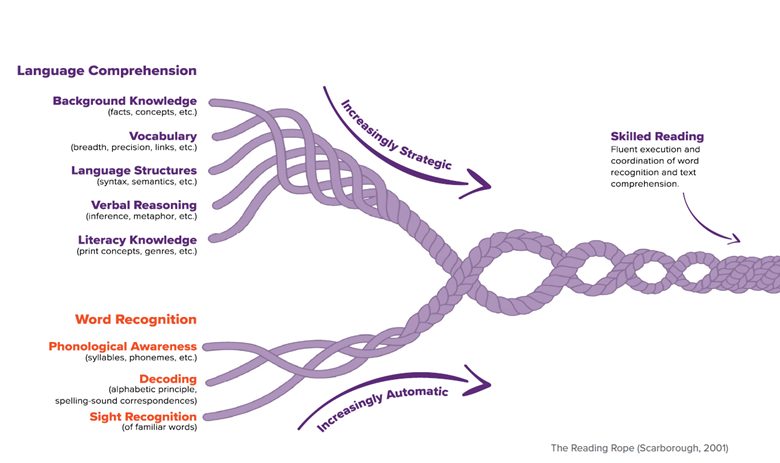Reading
The most widely used definition and model of reading is the Simple View of Reading. It asserts that reading comprehension is the product of the interaction between word recognition skills and language comprehension. Effective reading does not occur without both components. If there is a deficit in one component, there will be a deficit in the outcome. Word recognition and language comprehension have several subcomponents illustrated in the Reading Rope model below. Developed by Scarborough (2001), the Reading Rope provides a clear visual of the complex interactions and skills required to be a successful reader.

More children with Down syndrome are receiving reading instruction with the expectation that functional reading skills will develop. Research supports the use of comprehensive systematic approaches to reading instruction for individuals with intellectual disabilities (Allor, Mathes, Roberts, Cheatham & Al Otaiba, 2014; Lemons & Fuchs, 2010). These findings have important implications for developing reading interventions for individuals with Down syndrome because a behavioural phenotype has been documented and supported in the literature related to individuals with Down syndrome as having a relative strength in visual processing and a relative weakness in phonological processing (Buckley, 2001; Fuchs, 2006; Fidler, Most, & Philofsky, 2009). This finding promoted a trend that limited reading instruction to functional sight word-based approaches over phonics-based approaches for individuals with Down syndrome (Lemons & Fuchs, 2010). The DSRF approach uses the visual strengths of learners with Down syndrome to provide a solid foundation in sight word acquisition, so that students understand that the purpose of reading is to make meaning. This is most successful using personal connections with words that are most meaningful to them.
With careful programming, children with Down syndrome can learn to read as soon as they are “table ready,” that is, able to sit at a table and respond to and cooperate with an instructor for approximately five minutes (Broun, 2007). Children with Down syndrome can benefit from an early start with reading instruction. Findings from the literature emphasize the need of students with Down syndrome for more repetition and more time to learn new concepts and materials (Al Otaiba and Hosp, 2001; Allor et al., 2010). Studies have shown that children with Down syndrome who are introduced to literacy as a language teaching tool in preschool years reach the highest level of achievement (Buckley, 2001).
In studies by Laws and Gunn (2002) and Lemons and Fuchs (2010), results indicate that individuals with Down syndrome may develop phonological awareness as a result of reading, thus tangling up linear stage models of language and reading development. Careful planning for the individual, including assessment of phonological awareness and providing supports to develop phonological awareness while providing instruction in letter-sound correspondence and the alphabetic principle allows our learners with Down syndrome to begin strengthening the skills they need to become successful decoders and to comprehend the texts they are reading.
Many children with Down syndrome can acquire useful levels of reading ability given structured reading instruction despite having relatively poor language and memory skills (Byrne, MacDonald, Buckley, 2002). Reading activities play an important part in developing speech and language competence and working memory capacity. Further, reading is essential for the development of both social and academic success and for independent living (Buckley, 2009). Providing a fun and supportive learning environment that incorporates individual student interest while focusing on the skills most important in reading instruction for learners with Down syndrome sets the stage for success. Designing an individualized program for each student increases the confidence and persistence in students to learn and apply complex reading skills.
DSRF Resources
Get Ready for Reading and Spelling
Other Resources
Canadian Down Syndrome Society
International Guidelines for the Education of Learners with Down Syndrome (Down Syndrome International)
Literacy instruction for learners with Significant Disabilities (Literacy for All)
Florida Center for Reading Research
References
Al Otaiba, S., & Hosp, M. (2004). Providing Effective Literacy Instruction to Students with Down Syndrome. Teaching Exceptional Children, 36(4), 28-35.
Allor, J., Mathes, P., Roberts, J., Cheatham, J., & Otaiba, S. (2014). Is Scientifically Based Reading Instruction Effective for Students with Below-Average IQs? Exceptional Children, 80(3), 287-306.
Broun L & Oelwein P. Literacy Skill Development for Students with Special Learning Needs. 3, 17-18, 37, 54-55. 2007.
Buckley SJ. (2001). Reading and writing for individuals with Down syndrome – An overview. Down Syndrome Issues and Information. doi:10.3104/9781903806098
Buckley S. Learners With Down Syndrome: A Handbook for Teaching Professionals. 20-21. 2009.
Byrne A, MacDonald J, Buckley S. (2002). Reading, language and memory skills: A comparative longitudinal study of children with Down Syndrome and their mainstream peers. British Journal of Educational Psychology. 72, 513–529.
Cain, K. and Oakhill, J. V. (2006). Profiles of children with specific reading comprehension difficulties. British Journal of Educational Psychology. 76, 683–696.
Fidler, D., Most, D., & Philofsky, A. (2009). The Down syndrome behavioural phenotype: Taking a developmental approach. Down Syndrome Research and Practice, 12(3), 37-44.
Fuchs, D. (2006). Cognitive Profiling of children with genetic disorders and the search for a scientific basis of differentiated education. In P. Alexander & P. Winne (Eds.), Handbook of educational psychology (pp. 187-206). Mahwah, NJ: Erlbaum.
Gough, P. B., Hoover, W. A., and Peterson, C. L. (1996). Some Observations on a Simple View of Reading. In Cornoldi, C. & Oakhill, J (Eds.), Reading Comprehension Difficulties: Processes and Intervention (pp.1-14). Mahwah, New Jersey: Lawrence Erlbaum Associates, Inc., Publishers.
Lemons, C., & Fuchs, D. (2010). Modeling Response to Reading Intervention in Children With Down Syndrome: An Examination of Predictors of Differential Growth. Reading Research Quarterly, 45(2), 134-168.
Roch, M., & Levorato, M. C. (2009). Simple view of reading in down’s syndrome: The role of listening comprehension and reading skills. International Journal of Language & Communication Disorders, 44(2), 206-223.
Scarborough, H. S. (2001). Connecting early language and literacy to later reading (dis)abilities: Evidence, theory, and practice. In Neuman, S. & Dickinson, D. (Eds.), Handbook for research in early literacy (pp. 97-110). New York: Guilford Press. Google Scholar

